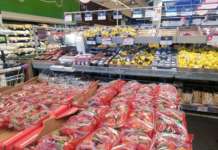The consequences of the energy crisis slow down Made in Italy fruit and vegetable exports: in the first nine months of 2022, exports registered +0.3% in value and -2.6% in volume, according to Fruitimprese’s elaboration on Istat data. On the contrary, imports increased (+16.8% in value, +6.8% in volume). The quantities imported (over 2.7 million tonnes) exceed those exported (2.6 million tonnes). And the trade balance goes from 781 million in the first nine months of 2021 to 291 million (-62%). The data are in contrast with those of 2021, a record year for Italian fruit and vegetable exports, with a value of more than 5.2 billion Euros (+8.3% compared to the previous year) and a trade balance of over 1 billion of Euro. Marco Salvi, president of Fruitimprese, commented: ‘The latest data indicate a recovery in exports. We have to see what happened in the last few months of the year: there are imported products that could slow down their growth trend, such as citrus fruits for example; other exported products, such as apples and kiwis, whose campaign began in August-September, should grow. It must be said that our Country, traditionally dedicated to exports, is experiencing some difficulties, the trade balance in volume is negative and has lost almost 500 million Euros in value. At the end of the year, the export turnover will probably be confirmed as exceeding 5 billion Euros, above all thanks to the effect of inflation, but the balance of trade will hardly return to the values of 2021’.
As for exports, negative signs in value, in particular, concern dried fruit (-28%) and citrus fruits (-3%). On the other hand, fresh fruit (+5.7%) is doing well: it continues to dominate with over 50% of the total quantities exported, legumes and vegetables (+3%). Reviewing the most marketed fruit products, the best performances are for peaches and nectarines, which grew by 45.9% in volume and 42.7% in value; positive signs in terms of value also concern kiwifruit (+3.2%), lemons (+7.7%), table grapes (+1.9%). A strong decline was recorded for pears (-43.8%), oranges (-10.9), and apples (-5%).
One figure that stands out is that of the increase in import volumes, with almost all double-digit increases in value: legumes-vegetables (+37%), citrus fruits (+17.8%), dried fruit (+14.4 %), tropical fruit (+11.5%). Among the most imported products, avocados stand out with growth both in volume (+22.3%) and in value (+15.1%), while pineapples and bananas grew only in value (respectively +18.3% and +11 .8%). ‘Italy imports more and more, even traditionally national products, such as vegetables and citrus fruits. There are consumers who are getting used to the imported product as a complement to the range of the Italian one’. But how can we strengthen our fruit and vegetable exports? ‘It’s lively, but Italian products are often penalized, we are less competitive compared to other producing Countries. The loss of competitiveness is due to various factors, including higher costs than those of competitors, especially if we consider the labour. Government’s intervention, with a reduction of the tax wedge, was positive, to have a situation more in line with other Countries. We also asked for a simplified procedure for hiring seasonal workers and a tax credit to compensate companies for the higher costs incurred for all production factors: packaging, fertilizers, agricultural diesel, sea freight, road transport’. The cost of energy is one of the key points. ‘Companies in our sector are energy-intensive, they need to preserve fruit day and night 365 days a year. Photovoltaic plants are a resource, but they do not give us continuity in energy production’.
Another factor that could help the sector is aggregation. ‘There are virtuous examples such as in the apple sector. We should extend this model. In some areas work is being done in this direction, such as for kiwifruit, where groupings of companies have been set up to share a greater presence on distant markets, export better, sharing the brand. Unapera was born in the pear sector (AOP that aggregates 25 companies, 13 PO and 12 non PO, ed): it is an important example to imitate’. The obstacles to imports by some important third Countries remain a problem. ‘There are still too many phytosanitary barriers. We have to work politically and diplomatically. In China we can only propose kiwifruit: here the demand for the yellow one is increasing, but the traditional one is losing ground’.








